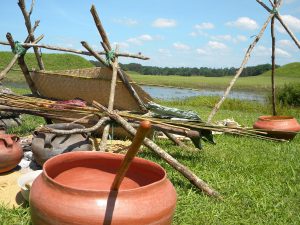
TUSCALOOSA, Ala. — The University of Alabama’s Moundville Archaeological Park resumes its Saturday in the Park program next month.
Saturday in the Park is a series of demonstrations and presentations related to Native Americans, archaeology, natural history, sustainable gardening and more. Most programs, which run from 11 a.m. to 4 p.m., have a hands-on activity for children.
Upcoming Saturday in the Park topics
March 5: Ancient Tools and Weapons
Retired U.S. Marine and weapons expert Bill Skinner displays and discusses an assortment of implements used by the Southeastern Indians for hunting and fishing. Visitors can throw an atlatl, a spear thrower used prior to the invention of the bow and arrow, or Choctaw rabbit sticks – one of the first “weapons” young boys were allowed to use. Blowguns, the bow and arrow, various types of fishing equipment and stone tools are some of the items visitors can see and learn how they were used. Children can make and try out their own sling made from natural fibers.
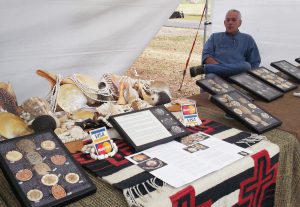
March 19: Southeastern Indian Shell Carving
Dan Townsend (Muscogee) grew up in the Keys but now lives and works in Tallahassee, Florida. His work is in collections throughout the world – including Thailand, Denmark, South Africa, China, Russia, New Guinea, Australia, Borneo and Vietnam. Pieces he has created are in use by a number of tribal communities as instruments in ceremonial teachings.
Townsend was among a select number of Native American artists invited to display their work at the opening of the Smithsonian’s National Museum of the American Indian. He has also served as an artist-in-residence at the Art Institute of Chicago.
Townsend’s exquisitely carved gorgets (pendants), medicine cups and earrings are created from lightning whelk shell, gold or black mother-of-pearl, melon shell and abalone. Many of his designs are inspired by shell carvings found at ceremonial sites around the Southeast.
Townsend will display his work, discussing the meanings of the designs he carves with visitors. Children can string a shell to make a necklace of their own.
March 26: Prehistoric Textiles
An award-winning Muscogee basket maker and textile artist from Bixby, Oklahoma, Mary Smith will present different prehistoric weaving techniques. Smith was an artist-in-residence at Moundville Archaeological Park during the Jones Museum renovation in 2009. Among other things, she created the featherwork cape worn by the chief in one of the museum’s recreated scenes. She is a master basket and mat weaver who researched and rediscovered an ancient method used by Muscogees to finish their baskets using “a double false braided rim.” Her works have won numerous awards and are in private collections and the permanent collections of several museums in Oklahoma. She will have a “make and take” weaving activity for children.
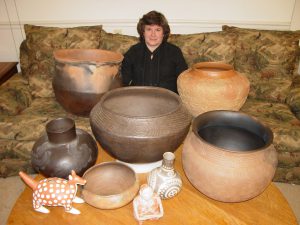
April 2: Southeastern Pottery
One of the best at what she does, Tamara Beane (Cherokee) has studied some of the finest pottery in archaeological collections all over the Southeast. In addition to her contemporary work, which has roots in the Cherokee culture, Beane replicates different Native American ceramic traditions from various places and prehistoric and historic time periods.
She has played a major part in revitalizing pottery making, both in traditional and contemporary formats, among the Eastern Band of Cherokee Indians. In addition to displaying her work, Beane will perform an out-of-door pottery firing in a manner as ancient as some of the pottery she reproduces.
Children can play with clay, trying out different tools that would have been used by prehistoric and historic Native Americans.
April 9: Ancient Hunting and Fishing
Retired U.S. Marine and weapons expert Bill Skinner displays and discusses an assortment of implements used by the Southeastern Indians for hunting and fishing. Children can make and try out their own sling made from natural fibers.
April 16: Mother Earth and the Three Sisters Garden Day
The park’s Americorps Volunteer in Service to America, Kenric Minges, other volunteers and education staff host a day of fun in the garden. Visitors learn that Native Americans interplanted corn, beans and squash, the “Three Sisters,” developing one of the earliest methods of sustainable agriculture. Other plants harvested and/or grown and used by Southeastern Indians, many of which we now consider “weeds,” are included as part of a garden tour. “Black drink,” a traditional tea made from yaupon holly, as well as a trail mix featuring nuts and berries indigenous to North America, will be available for visitors to sample. Children get to decorate a miniature gourd flower pot, and then plant a sunflower in it.
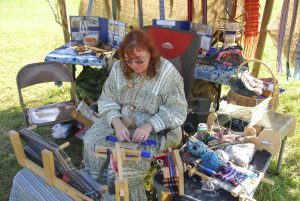 April 23: Cherokee Weaving and Textiles
April 23: Cherokee Weaving and Textiles
Prior to European contact, Cherokee people wove textiles without the aid of spinning wheels or large looms. Early Cherokee sashes, nets and other open weave fabrics were very similar to those made by the prehistoric people at Moundville Archaeological Park.
Catherine “Cat” Sloan (Cherokee) discusses how Euro-Americans intentionally introduced the spinning wheel and loom to change the division of labor among the Cherokee and other Southeastern Indian tribes.
Sloan displays a wide variety of textiles made using different weaving methods. Children can learn how to twine their own small bag.
April 30: Choctaw Baskets and Crafts
Ramsey King, of Conehatta, Mississippi, will demonstrate the art of river cane basketry. One of the few male Choctaw basket makers, King’s hand strength allows him to bend thicker river cane, making for an extra sturdy basket. He specializes in double-walled construction, which is a method where the inside of the basket is first woven from the bottom to the top and doubled over for the rim, the outside wall then woven downward. One of the old-style forms he weaves is a river cane quiver for arrows. He will be joined by his mother, Emma King, who will demonstrate traditional Choctaw beadwork. Both will have their works for sale, and children can string themselves a bead necklace.
May 7: Mississippian Copperwork
Until their impact with European cultures, native North Americans did not make things by melting metal. However, around 2,000 years ago Southeastern Indian people began working in copper. A fairly soft metal, copper could be heated and hammered into sheets. The sheets were cut and made into ceremonial ornaments – beads, bracelets, pendants and large plates embossed with religious designs. Experimentation is a large part of understanding and reproducing technologies from the past. Bill Skinner, of Thomaston, has focused his efforts on finding out exactly how the Mississippian culture, including the prehistoric Moundvillians, hand-fashioned this interesting class of artifacts.
May 14: Choctaw Crafts
Join Juanita Gardinski, of the Mississippi Band of Choctaw Indians, to learn about various traditions that make the Choctaw people unique. Gardinski will display and discuss appliqué dress and bead work sash making, as well as other kinds of bead work and basketry. She also tells why mounds, similar to those found at the park, are related to the origin and migration of the Choctaw people into Mississippi. Children can try their hand throwing Choctaw rabbit sticks – one of the first “weapons” a young boy might be given. Gardinski and her extended family have participated in the Moundville Native American Festival since its inception in 1989, dancing and demonstrating their traditions.
May 21: Prehistoric Mica Work
Mica is a shiny mineral that naturally occurs in layers, which can be split into thin translucent sheets. Because of its thermal properties, mica was used during historic times as windows for stoves. Prehistorically, starting around 200 B.C., Native Americans started crafting mica into delicate objects – ceremonial mirrors and ornaments that were probably sewn onto clothing. Tamera Beane, of Collinsville, creates and displays replicas of mica cutouts found in the
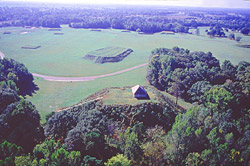
archaeological record. Also renowned as a potter who accurately reproduces different styles of prehistoric Southeastern Indian pottery, Beane has many pieces on display in the recreated scenes in the park’s Jones Archaeological Museum. This includes an elegant set of small mica “sun circles” sewn onto the bottom of the ruling clan mother’s skirt.
Moundville’s Saturday in the Park is a series of programs featured during the spring, early summer and fall. The programs are free with paid park admission. Admission is $6 for students (through college age with student ID) and $8 for adults. Moundville Archaeological Park is located 13 miles south of Exit 71-A off of Interstate 20/59.
Contact
Kim Eaton, UA media relations, 205/348-8325, kkeaton@ur.ua.edu
Source
Betsy Irwin, Moundville Archaeological Park Education Outreach Coordinator, 205/371-8732, birwin@ua.edu